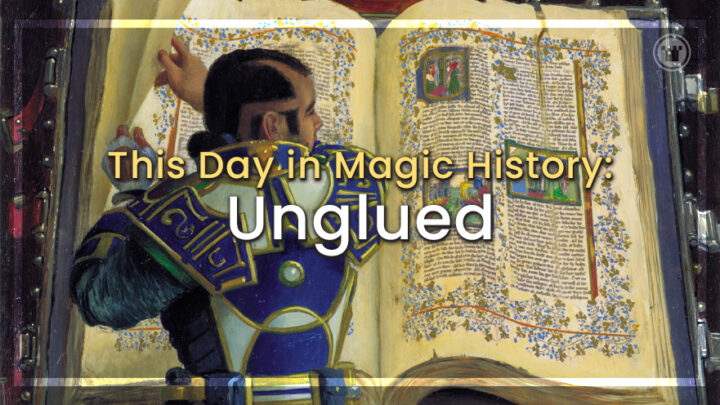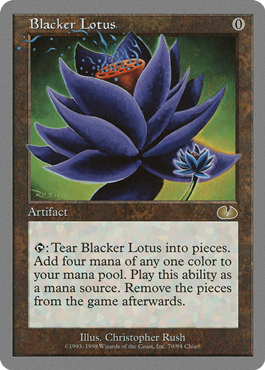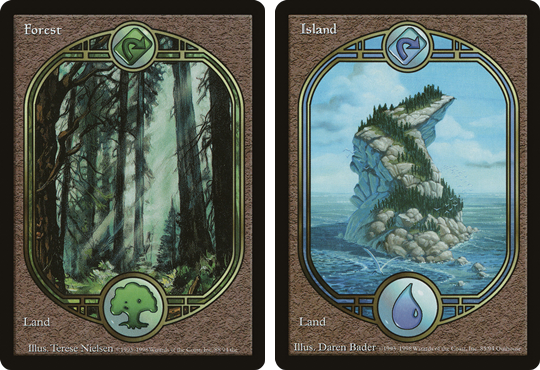Welcome back to another edition of “This Day in Magic History.” Twenty four years ago today, Unglued ” was released as Magic’s very first joke set. The cards created for the set were intentional references and jokes about the game of Magic itself. This premise proved fairly popular, and since the 1998 release of Unglued we have seen three more of these Un-sets.
We’ll also be getting a fifth Un set on Oct. 7: Unfinity. This makes it a particularly apt time to take a look back at the Un-set that started it all!
The Origins of Unglued
The idea for Unglued came about in 1997. At that point, Magic was three years old and, while there had been a few hiccups here and there (see: Homelands), for the most part the game was selling incredibly well with an ever-growing community of players all over the world. This meant it would be possible to create a set that only the most enfranchised players would understand.
Magic’s brand manager at the time, Joel Mick, was the first to come up with the idea of releasing a set that was intentionally not tournament legal. He wanted these cards to have silver borders to signify that they were very different from your usual Magic cards.
Mick thought this was a fun concept because it would allow the designers a lot more leeway in designing cards. In a lot of ways, cards needing to work in a tournament environment had limited what designers could do. This is well-represented by Chaos Orb, which ultimately was banned because resolving its effect was simply impractical.
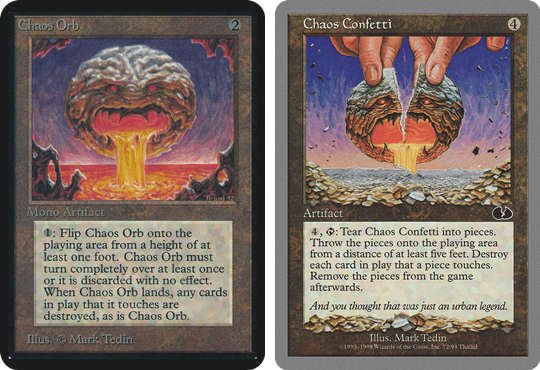
Current head designer Mark Rosewater suggested making Unglued a joke set when he was fresh off of leading the design on Tempest. In a past edition of this series, I discussed how Mark Rosewater’s career at Wizards of the Coast began, and you might remember he actually came from the comedy screenwriting world. A joke set like Unglued allowed him to flex his comedy-writing and game designing muscles at the same time.
Ultimately, Rosewater became the lead designer of Unglued. Wizards of the Coast had a pretty small staff at the time, too, so he was a one-man design team for the set. That’s right — he conceived of and designed every single card in the set. He was even the artist for one of the cards.
In the end, every single card in the set had some sort of effect that would never work in tournament Magic. The funniest cards in the set, though, are generally those that reference the designers and players of Magic itself — like the aforementioned Chaos Confetti.
A couple of my other favorites include “Look at Me, I’m The DCI” and “Blacker Lotus.” “Look at Me, I’m the DCI” pokes fun at the process by which cards were banned at the time, both with its art and effect. “Blacker Lotus,” meanwhile, makes reference to the most powerful cards in the game. It actually has a more powerful effect than the original Lotus, but…you have to tear it apart to actually use it.
In the end, Unglued did not sell especially well. This isn’t too surprising, as only the most enfranchised of players would really understand the set’s purpose. Those who did play with the set gave it rave reviews, though, and this is generally the pattern we have seen continue with more recent silver-bordered releases. The sets aren’t really designed to sell booster packs — they are designed so Magic’s most passionate audience can have a wacky, fun time.
The First Full-Art Cards
While most of Unglued’s legacy can only be seen in Un-sets, there were two innovations in the set whose legacy can be seen more broadly in Magic. Unglued was the first set to feature full-art lands. And, in fact, this was the first time there was ever a full-art card of any kind!
These lands received a black border instead of the characteristic silver border of the other cards in the set, meaning they were tournament legal. These quickly became the most sought-after basic lands, and you can see why. They looked unlike any land — or Magic card — anyone had ever seen. For a long time, full-art lands were only featured in Un-sets, as one of their major gimmicks.
Full-art lands ultimately proved so popular that they became available in regular booster packs for the first time in 2009’s Zendikar, and we have seen them returned fairly regularly in Standard-release sets ever since.
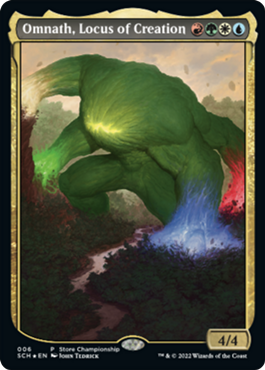
The trend of full-art lands also ultimately resulted in the creation of other full-art cards, although these have largely appeared as promo cards.
The first Creature Tokens

These days, booster packs always include tokens that can be used with cards printed in the same set — and that’s a practice that began with a joke set. Before Unglued, if you had a card that made creature tokens, you had to find your own way to represent that token.
But with Unglued, you could open creature tokens in booster packs. The tokens didn’t actually have Power and Toughness printed on them, so they weren’t perfect for game play, but it did mark the beginning of a practice that has continued to be used in mainstream Magic releases.
End step
Unglued was a major success and really proved that the game of Magic had created a very passionate community that could be “in” on a whole lot of jokes.
While we don’t know a ton about Unfinity at this point, you can bet there will be some pretty awesome meta-jokes. But Unglued’s influence can still be seen in Standard-release booster packs we open today, with the inclusion of token cards and full-art lands.

Jacob has been playing Magic for the better part of 24 years, and he especially loves playing Magic’s Limited formats. He also holds a PhD in history from the University of Oklahoma. In 2015, he started his YouTube channel, “Nizzahon Magic,” where he combines his interests with many videos covering Magic’s competitive history. When he’s not playing Magic or making Magic content, he can be found teaching college-level history courses or caring for a menagerie of pets with his wife.

